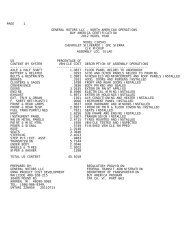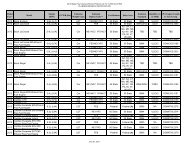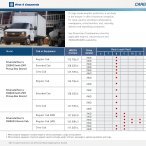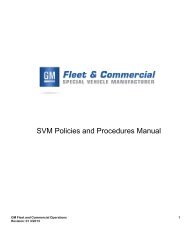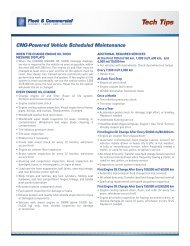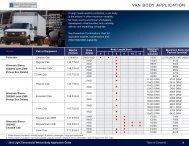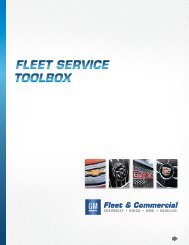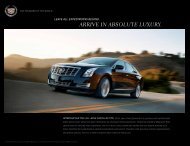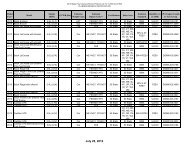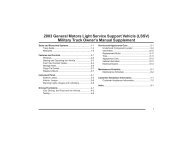2013 Tahoe Technical Guide (pdf) - GM Fleet
2013 Tahoe Technical Guide (pdf) - GM Fleet
2013 Tahoe Technical Guide (pdf) - GM Fleet
Create successful ePaper yourself
Turn your PDF publications into a flip-book with our unique Google optimized e-Paper software.
Vehicle load limits | 21<br />
This information is intended for those who intend to install additional equipment to the police vehicle after it has left the factory, and for those<br />
who will be driving and loading the vehicle with passengers and/or cargo. Two labels on your vehicle show how much weight it was designed<br />
to carry, the Tire and Loading Information label and the Certification/Tire label. These labels are attached to your vehicle and give you the<br />
maximum load capacity, the Gross Vehicle Weight Rating (GVWR) and the Gross Axle Weight Rating (GAWR) for your vehicle. See "Vehicle Load<br />
Limits" in the owner manual Index for additional loading information.<br />
The following guidelines can help you with proper loading and load distribution when installing additional equipment on the <strong>Tahoe</strong>Police<br />
Package.<br />
WARNING<br />
Do not load the vehicle any heavier than the Gross Vehicle Weight Rating (GVWR), or either the maximum front or<br />
rear Gross Axle Weight Rating (GAWR). This can cause systems to break and change the way the vehicle handles.<br />
This could cause loss of control and a crash. Overloading can also shorten the life of the vehicle.<br />
Adding Equipment to Your Vehicle<br />
Before adding accessories or equipment to your police vehicle, there are some things you need to know<br />
• The police vehicle's maximum capacity weight (payload). The weight of your police vehicle, including a full tank of fuel but without<br />
a driver and passengers.<br />
• The weight of items you plan on adding to your police vehicle, like roof mounted light bar(s), push bumpers, security barrier(s), rear<br />
storage organizer, highway flares, fire extinguishers, weapons, ammunition, radios, and video equipment.<br />
• The weight and number of passengers you intend to carry in your vehicle.<br />
• The total weight of any additional cargo you intend to carry in your vehicle.<br />
When planning your vehicle equipment installation remember not to exceed the Gross Vehicle Weight Rating (GVWR) or the Gross Axle Weight<br />
Rating (GAWR) of the front or rear axles. To keep the available load weight less than the vehicle capacity weight, you may need to limit the<br />
number of passengers you carry in your vehicle or change your choice of additional equipment.<br />
Center of Gravity (CG)<br />
A vehicle's center of gravity is an imaginary location inside the vehicle and is a balance point for the vehicle mass as it moves down the road. The<br />
police vehicle's center of gravity, before you add a load and passengers, is approximately midway between the center of the axles, up from the<br />
ground to just below the front window, and between the driver and passenger. Equipment location and weight on the vehicle's center of gravity<br />
is important to keep in mind when planning an installation. Heavy equipment should be positioned as low and as far forward in the rear load<br />
compartment as possible. Try to mount the equipment below the bottom of the side windows. Refer to the Loading Zone chart and diagram to<br />
help with your installation plan.<br />
A procedure to make the necessary measurements and formulas to calculate the vehicle longitudinal, lateral and vertical position of the center<br />
of gravity can be found in the <strong>GM</strong> Coachbuilders Manual.<br />
Equipment required to conduct the measurements for calculating the center of gravity are:<br />
• Weight scales of sufficient capacity to measure the vehicle weight at each wheel.<br />
• A post type hoist or other means to safely elevate the front of the vehicle to at least an angle of 20 degrees above horizontal.<br />
See your <strong>GM</strong> dealer to get more information about this coachbuilder procedure.<br />
Keeping the center of gravity midway between the axles is also important to provide proper braking performance. About half the total vehicle<br />
weight on each axle is recommended.<br />
Weigh your vehicle after the additional equipment has been installed to determine the actual weight of your vehicle. Weigh the vehicle with a<br />
full tank of fuel and without passengers. You may need to put a limit on how many people or other equipment you can carry inside your vehicle<br />
after the additional equipment has been installed.<br />
Note: See loading zone weight chart and diagram on page 10<br />
<strong>2013</strong> Chevrolet Municipal Vehicles <strong>Technical</strong> Manual





